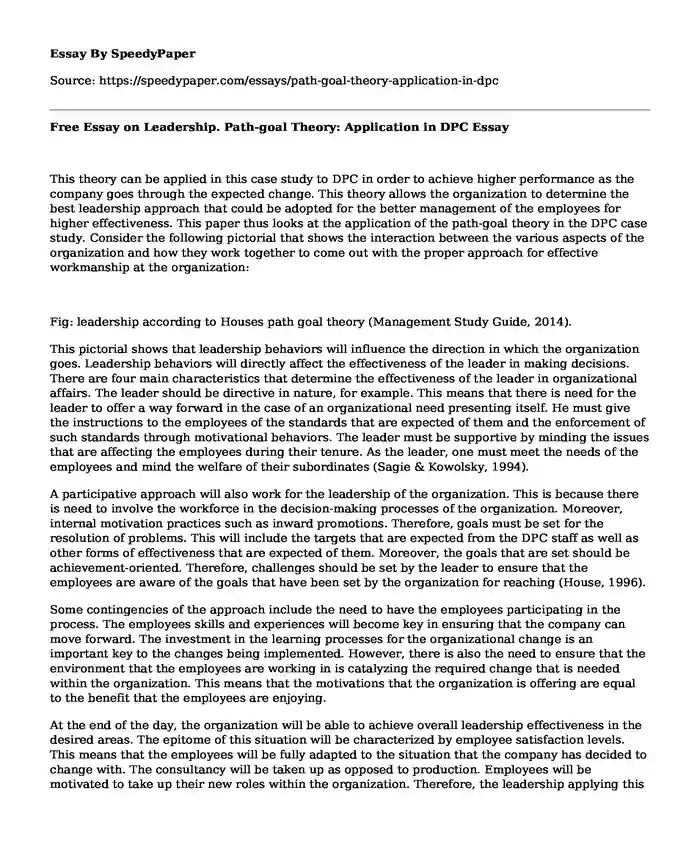
| Type of paper: | Essay |
| Categories: | Leadership analysis Goal Management |
| Pages: | 3 |
| Wordcount: | 612 words |
This theory can be applied in this case study to DPC in order to achieve higher performance as the company goes through the expected change. This theory allows the organization to determine the best leadership approach that could be adopted for the better management of the employees for higher effectiveness. This paper thus looks at the application of the path-goal theory in the DPC case study. Consider the following pictorial that shows the interaction between the various aspects of the organization and how they work together to come out with the proper approach for effective workmanship at the organization:
Fig: leadership according to Houses path goal theory (Management Study Guide, 2014).
This pictorial shows that leadership behaviors will influence the direction in which the organization goes. Leadership behaviors will directly affect the effectiveness of the leader in making decisions. There are four main characteristics that determine the effectiveness of the leader in organizational affairs. The leader should be directive in nature, for example. This means that there is need for the leader to offer a way forward in the case of an organizational need presenting itself. He must give the instructions to the employees of the standards that are expected of them and the enforcement of such standards through motivational behaviors. The leader must be supportive by minding the issues that are affecting the employees during their tenure. As the leader, one must meet the needs of the employees and mind the welfare of their subordinates (Sagie & Kowolsky, 1994).
A participative approach will also work for the leadership of the organization. This is because there is need to involve the workforce in the decision-making processes of the organization. Moreover, internal motivation practices such as inward promotions. Therefore, goals must be set for the resolution of problems. This will include the targets that are expected from the DPC staff as well as other forms of effectiveness that are expected of them. Moreover, the goals that are set should be achievement-oriented. Therefore, challenges should be set by the leader to ensure that the employees are aware of the goals that have been set by the organization for reaching (House, 1996).
Some contingencies of the approach include the need to have the employees participating in the process. The employees skills and experiences will become key in ensuring that the company can move forward. The investment in the learning processes for the organizational change is an important key to the changes being implemented. However, there is also the need to ensure that the environment that the employees are working in is catalyzing the required change that is needed within the organization. This means that the motivations that the organization is offering are equal to the benefit that the employees are enjoying.
At the end of the day, the organization will be able to achieve overall leadership effectiveness in the desired areas. The epitome of this situation will be characterized by employee satisfaction levels. This means that the employees will be fully adapted to the situation that the company has decided to change with. The consultancy will be taken up as opposed to production. Employees will be motivated to take up their new roles within the organization. Therefore, the leadership applying this will be accepted as the organization moves back into prosperity.
References
House, R. (1996). Path-goal theory of leadership: Lessons, legacy, and a reformulated theory. The Leadership Quarterly, 323-52.
Management Study Guide. (2014). Houses Path Goal Theory. Retrieved from Management Study Guide: http://managementstudyguide.com/houses-path-goal-theory.htm
Sagie, A., & Kowolsky, M. (1994). Organizational attitudes and behaviors as a function of participation in strategic and tactical change decisions: An application of pathgoal theory. Journal of Organizational Behavior, 37-47.
Cite this page
Free Essay on Leadership. Path-goal Theory: Application in DPC. (2019, Sep 06). Retrieved from https://speedypaper.net/essays/path-goal-theory-application-in-dpc
Request Removal
If you are the original author of this essay and no longer wish to have it published on the SpeedyPaper website, please click below to request its removal:
- Free Essay on Economic Effects of Marriages
- Pharmacy Loyalty Paper Sample
- Essay Sample with the Focused Assessment: Behavioral and Mental Health
- Nordstrom market analysis
- Soundtrack Analysis of a Scene in the Film Matrix (1999). Essay Sample
- Free Essay. Appadurai's 5 Scapes of Globalization
- Essay Sample on The Life Of Chief Pontiac
Popular categories




